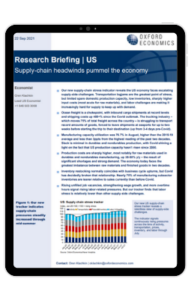Research Briefing
| Sep 22, 2021
Supply-chain headwinds pummel the US economy

Our new supply-chain stress indicator reveals the US economy faces escalating supply-side challenges. Transportation logjams are the greatest point of stress, but limited spare domestic production capacity, low inventories, sharply higher input costs (most acute for raw materials), and labor challenges are making it increasingly hard for supply to keep up with demand.
What you will learn:
- Ocean freight is a chokepoint, with inbound cargo shipments at record levels and shipping costs up 400+% since the Covid outbreak. The trucking industry – which moves 75% of total freight across the country – is struggling to transport record amounts of goods, forced to leave shipments at seaports for up to two weeks before starting the trip to their destination (up from 3-4 days pre-Covid).
- Manufacturing capacity utilization was 76.7% in August, higher than the 2015-19 average and less than 3ppts from the highest reading of the past two decades.
- Slack is minimal in durables and nondurables production, with Covid shining a light on the fact that US production capacity hasn’t risen since 2000.
- Production costs are sharply higher, most notably for raw materials used in durables and nondurables manufacturing, up 35-55% y/y – the result of significant shortages and strong demand. The economy today faces the greatest imbalance between raw materials and finished goods in two decades.
Tags:
Related Services

Post
US Key Themes 2026: Exceptionalism amid fragmentation
US exceptionalism is alive and well, and that won't change in 2026.
Find Out More
Post
Global Key themes 2026: Bullish on US despite AI bubble fears
We anticipate another year of broadly steady and unexceptional global GDP growth, but with some more interesting stories running below the surface.
Find Out More[autopilot_shortcode]
